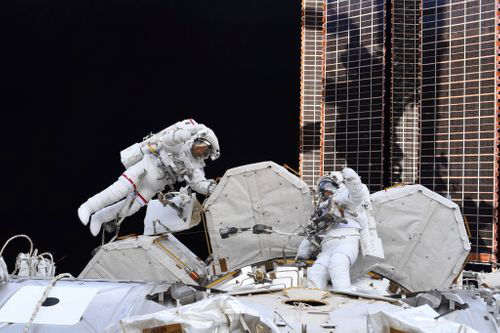NASA astronauts Victor Glover, Mike Hopkins conduct spacewalk Wednesday

Astronauts Mike Hopkins and Victor Glover Jr. conducted a spacewalk Wednesday to upgrade and maintain the International Space Station.
It was the first spacewalk experience for Glover, who is a few months into his first spaceflight on the station.
“What a beautiful view,” Glover said after he began the spacewalk.
This was the third spacewalk for Hopkins, who previously completed two spacewalks during his first six-month venture to the space station from September 25, 2013, to March 10, 2014.
The spacewalk officially began at 6:28 a.m. ET and ended at 1:24 p.m. ET. It lasted for about six hours and 56 minutes.
This is the 233rd spacewalk in support of the space station.
Hopkins wore the spacesuit bearing red stripes as crew member 1 and Hopkins was in the spacesuit with no stripes as crew member 2.
The astronauts focused on progress with the installation of Bartolomeo, the newest payload hosting station outside the European Space Agency’s Columbus module. They worked on antenna and cable rigging to hook up power and data connections.
The Bartolomeo platform, named after the younger brother of Christopher Columbus, is the first instance of a European commercial partnership that offers a place to conduct science and technology demonstrations outside of the space station, according to the European Space Agency.
The Columbus module was also upgraded with a terminal that provides an independent high-bandwidth communication link for European ground stations.
The two astronauts encountered a few issues trying to connect two of the cables, so ground teams will troubleshoot solutions and the task will be added to a future spacewalk.
During the spacewalk, Glover jettisoned a protective covering that was no longer needed for the antenna.
“@AstroVicGlover jettisons a science antenna cover into space since it is no longer needed. It will eventually enter Earth’s atmosphere and burn up safely,” according to a tweet from the International Space Station account.
The two astronauts joked after five hours that they wished they could go to the space station’s airlock and pop in for some “snacks and bacon.”
Even though their heavy suits are weightless, astronauts often say spacewalks are the most physically challenging and most grueling tasks they do in space.
Hopkins and Glover also have a second spacewalk scheduled for February 1.
The astronauts will install the final lithium-ion battery adapter plate on Monday. This installation wraps up work to complete the replacement of aging batteries outside the station that began in January 2017.
Hopkins, Glover, NASA astronaut Shannon Walker and Japan Aerospace Exploration Agency astronaut Soichi Noguchi flew to the station in November aboard the SpaceX Crew Dragon Resilience spacecraft. They joined NASA astronaut Kate Rubins and Russian cosmonauts Sergey Ryzhikov and Sergey Kud-Sverchkov, who were already on the station after launching in October.
During both spacewalks, Rubins has the task of operating the robotic arm from inside the space station to assist the astronauts as they work outside.
They will focus on other upgrades, like replacing an external standard camera with a new high-definition camera on the Destiny laboratory, and will replace camera and light assembly components needed for the Japanese robotic arm’s camera system, located outside of the Kibo module.
“We’ve been talking about these two EVAs (extra-vehicular activities) for the better part of a year, so we’re excited to see them executed,” said Kenny Todd, deputy manager for the International Space Station Program at NASA during a press conference Friday.
There are more spacewalks planned for the crew near the end of February and beginning of March.
Glover and Rubins will pair up for the third spacewalk to prepare the station’s power system for installing new solar arrays, which will increase the station’s power supply.
Rubins and Noguchi will conduct the fourth spacewalk to continue upgrades for the space station.
During these long spacewalks, the astronauts go through alternating cycles of day and night every 45 minutes, operating against the hot, bright light of the sun as well as the cold darkness of space. This happens because the space station is orbiting the Earth at 17,500 miles per hour.
While the astronauts don’t feel the direct impacts of extreme cold and heat, there is the potential for a chill, so there are heaters installed in the astronauts’ gloves to keep their hands warm, said Vincent LaCourt, spacewalk flight director at NASA for the February 1 spacewalk.